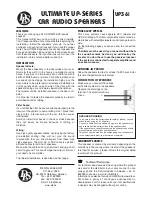
ENGLISH
CONNECTION
INSTRUCTIONS
This operation must be carried out with all equipment
switched off!
The rear panel of Lilium features two terminal boards,
one hosting the terminals for the positive polarity, the
other for the negative polarity. These accept connection
with spade connectors, bananas, and with bare cables.
If we analyse the two boards bottom up, the first
horizontal pair of positive and negative terminals
feeds – separately – the medium-high frequencies of
the speakers. The second pair feeds, separately, the
front woofers; while the third pair is designed to feed
the infra-woofer, still separately. Please refer to the
illustration in figure 10.
Inside the package, all the connection jumpers are
already installed on Lilium’s terminal board. The full
set of one Lilium speaker consists in four jumpers
(therefore, eight jumpers per pair).
By using the right amount of these jumpers, Lilium can
be connected according to the most usual configurations
and be easily adapted to the different types of ending of
the power cables preferred by the users. In the case of
banana connections, each terminal must be unscrewed
first in order to remove the plastic cap that protects each
pin.
Please find below a description of the different
connections; the sequence of these connections is
marked by a progressive escalation in the quality of the
sound reproduction in terms of definition, control and
details.
The standard connection requires a single stereophonic
amplifier or a pair of monophonic amplifiers, together
with a single kit of power cables.
The connection shall be made by leaving the terminals
connected one to the other by means of the jumpers, as
they are already set when the speaker is unpacked, and
as shown in figure 10.
This type of connection improves the general reproduc-
tion quality, and in particular the bass frequencies. It is
performed by using a single stereophonic amplifier or a
pair of monophonic amplifiers, together with two kits
of power cables. This configuration can be implemented
on the Lilium speaker in two options:
I.
The option we deem better sees the medium-high
section fed by a power cable, and the low and
infra-low frequency sections fed by the other cable
together. For the correct jumper positioning, plea-
se refer to figure 11.
MONO-WIRING
OR STANDARD CONNECTION
BI-WIRING
The tri-wiring connection is made with a single stere-
ophonic amplifier or a pair of monophonic amplifiers
together with three kits of power cables, where each ca-
ble feeds one section of Lilium, and by removing all the
jumpers (ref. figure 13).
Bi-amplification improves the reproduced sound in a ge-
neral manner, and in particular gives greater dynamics
and control of the bass frequencies. To produce this
configuration with either two stereophonic amplifiers or
four monophonic amplifiers, you need two pairs of po-
wer cables with which you can implement two options:
I.
The option we deem better is achieved by feeding
the medium-high section with a stereophonic am-
plifier (or a pair of monophonic amplifiers), and
the low + infra-low frequency sections with the
other stereophonic amplifier (or the other pair of
monophonic amplifiers). For the correct jumper
positioning, please refer to figure 14.
II. An interesting option is the one where the infra-
low section is fed by a stereophonic amplifier (or
a pair of monophonic amplifiers), while the me-
dium-high section and the low frequency section
are fed together by the other stereophonic ampli-
fier (or the other pair of monophonic amplifiers).
For the correct jumper positioning, please refer to
figure 15.
Tri-amplification is achieved with three stereophonic
amplifiers, or with six monophonic amplifiers together
with three kits of power cables. Here each stereophonic
amplifier (or each pair of monophonic amplifiers) feeds
one section of Lilium, after all the jumpers have been
removed (ref. figure 16).
This configuration is the apex in the gradual quality
rise, as specified in this chapter.
Finally, the accurate tightening of the contacts and a
periodical check of same contributes to improved per-
formance.
TRI-WIRING
BI-AMPLIFICATION
TRI-AMPLIFICATION
II. An interesting option is the one where the infra-
low section is fed by a power cable, while the
medium-high section is fed together with the low
frequency section by the other cable. For the cor-
rect jumper positioning, please refer to figure 12.
Summary of Contents for Lilium
Page 1: ......
Page 2: ......
Page 3: ......
Page 4: ......
Page 22: ...DATA SHEET...
Page 25: ...SUPPORT DRAWINGS...
Page 26: ...SUPPORT DRAWINGS 1 2...
Page 27: ...3 4...
Page 28: ...5 6 7 SUPPORT DRAWINGS...
Page 29: ...8 9...
Page 30: ...10 SUPPORT DRAWINGS...
Page 31: ...11 12...
Page 32: ...13 14 15 SUPPORT DRAWINGS L R L R L R L R L R...
Page 33: ...16 L R L R L R...
Page 34: ...17 SUPPORT DRAWINGS...
Page 35: ...18 1 1 0 0 0 60 00 1 1 0 0 0...
Page 36: ...19 SUPPORT DRAWINGS...
Page 37: ...20 21 22...
Page 47: ......
Page 48: ......












































